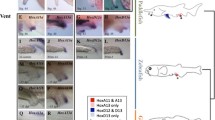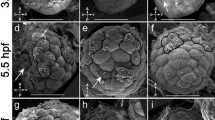Abstract.
The homeobox gene Distal-less (Dll) is well known for its participation in the development of arthropod limbs and their derivatives. Dll activity has been described for all groups of arthropods, but also for molluscs, echinoderms and vertebrates. Generally, Dll participates in the establishment of the proximo-distal-axis and differentiation along this axis. During our investigation of the expression pattern in the silverfish Lepisma saccharina and the horseshoe crab Limulus polyphemus, we found several expressions in late stages which cannot be explained with the "normal" limb-specific function. The antenna, cerci and terminal filament of the silverfish show a striped expression; single cells on the labrum, mandibles, maxillary palps and anal valves are also strongly stained by the Dll antibody. In addition to cell groups in the developing ganglia of the CNS, in the coxal endites and several nerve cells in femur and the trochanter of the prosomal limbs, the whole prosomal shield of Limulus polyphemus is surrounded by Dll-positive cell clusters. Furthermore, the lateral processes of the opisthosoma and the edges of the opisthosomal appendages are Dll positive. To get an indication of the cell fate of these regions, we examined hatched larvae and juvenile stages of both species with the SEM. We found a striking correlation of these Dll-positive areas and different sense organs, especially mechanoreceptors. Since many sense organs in arthropods are situated on the limbs, interpretation of the Dll expression in limbs is problematical. This has critical implications for comparative analysis of Dll expression patterns between arthropods and for the claim of homology between limb-like structures. Furthermore, we discuss the possibility of convergent appendage evolution in various bilaterian groups based on the improvement of spatial sensory resolution.
Similar content being viewed by others
Author information
Authors and Affiliations
Additional information
Electronic Publication
Rights and permissions
About this article
Cite this article
Mittmann, B., Scholtz, G. Distal-less expression in embryos of Limulus polyphemus (Chelicerata, Xiphosura) and Lepisma saccharina (Insecta, Zygentoma) suggests a role in the development of mechanoreceptors, chemoreceptors, and the CNS. Dev Genes Evol 211, 232–243 (2001). https://doi.org/10.1007/s004270100150
Received:
Accepted:
Issue Date:
DOI: https://doi.org/10.1007/s004270100150




